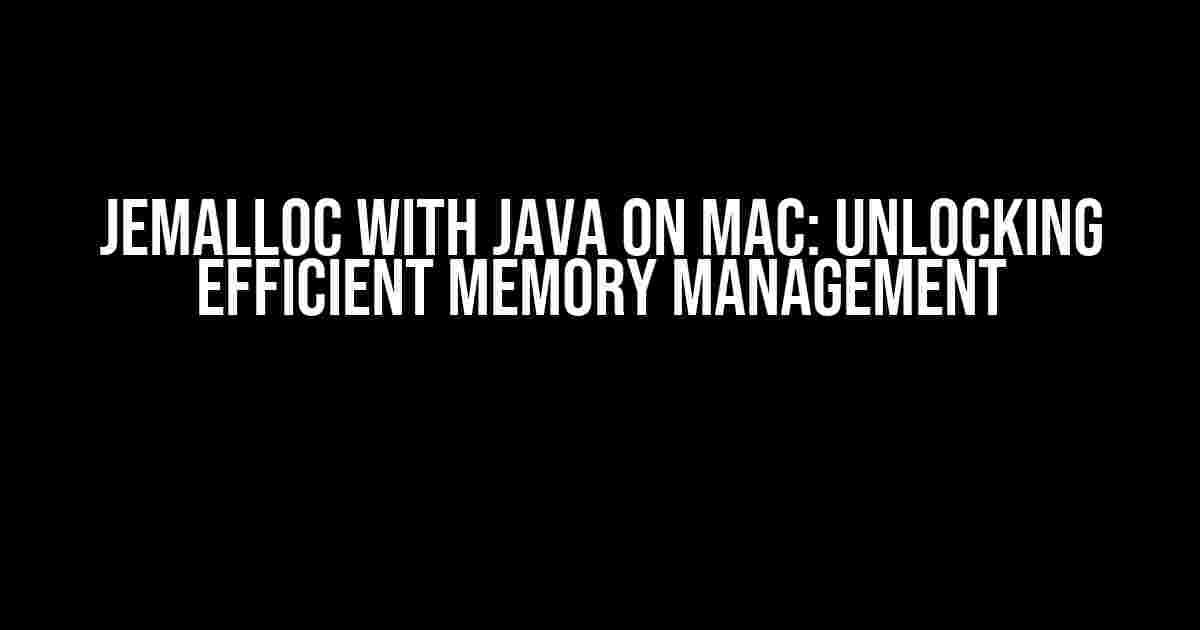Are you tired of dealing with memory-related issues in your Java applications on Mac? Look no further! In this article, we’ll explore the world of Jemalloc, a highly efficient memory allocator that can revolutionize your Java development experience. We’ll delve into the whys and hows of using Jemalloc with Java on Mac, and provide you with a comprehensive guide to get started.
What is Jemalloc?
Jemalloc is a highly scalable and efficient memory allocator developed by Facebook. It’s designed to handle the complexities of modern software development, providing a low-latency, low-overhead, and thread-friendly memory management system. Jemalloc is particularly useful for applications that require high-performance and low-pause-time garbage collection, making it an ideal fit for Java development.
Why Use Jemalloc with Java on Mac?
So, why would you want to use Jemalloc with Java on Mac? Here are some compelling reasons:
- Faster Application Startup**: Jemalloc reduces the time it takes for your Java application to start, making it ideal for real-time and latency-sensitive applications.
- Improved Memory Efficiency**: Jemalloc’s efficient memory allocation and deallocation mechanisms reduce memory fragmentation, leading to better performance and reduced memory usage.
- Enhanced Throughput**: By minimizing garbage collection pause times, Jemalloc allows your Java application to handle higher workloads and process larger datasets.
- Simplified Memory Management**: Jemalloc takes care of memory management for you, allowing you to focus on writing code rather than worrying about memory allocation and deallocation.
Installing Jemalloc on Mac
Before we dive into using Jemalloc with Java, let’s cover the installation process on Mac. You’ll need:
- Homebrew (a package manager for Mac)
- Xcode (for building and installing Jemalloc)
Open your terminal and run the following commands:
brew install jemalloc
This will install Jemalloc on your Mac. If you’re using a Mac with an M1 chip, you may need to use:
brew install jemalloc --build-from-source
Configuring Java to Use Jemalloc
Now that Jemalloc is installed, let’s configure Java to use it. You’ll need to set the `LD_PRELOAD` environment variable to point to the Jemalloc library:
export LD_PRELOAD=/usr/local/opt/jemalloc/lib/libjemalloc.so
Note: The above path may vary depending on your Jemalloc installation. You can verify the library path using:
brew --prefix jemalloc
Add the following line to your `~/.bashrc` or `~/.zshrc` file (depending on your shell) to make the change permanent:
export LD_PRELOAD=/usr/local/opt/jemalloc/lib/libjemalloc.so
Using Jemalloc with Java
Now that Jemalloc is configured, let’s explore how to use it with Java. You can use Jemalloc with any Java project, but for this example, we’ll create a simple Java application:
mkdir jemalloc-java-example cd jemalloc-java-example
Create a new Java file, `JemallocJavaExample.java`, with the following code:
public class JemallocJavaExample {
public static void main(String[] args) {
System.out.println("Hello, Jemalloc!");
}
}
Compile the Java file using:
javac JemallocJavaExample.java
Run the application using:
java -Xmx1024m -XX:+UseG1GC -XX:+UseJemalloc JemallocJavaExample
This will run the Java application with Jemalloc enabled. You can verify that Jemalloc is being used by checking the output of:
ps -ef | grep java
Look for the `LD_PRELOAD` environment variable in the output, which should point to the Jemalloc library.
Tuning Jemalloc for Optimal Performance
By default, Jemalloc is configured for general-purpose use. However, you can tune it for optimal performance in your Java application. Here are some key configuration options:
| Option | Description |
|---|---|
-Xmx |
Set the maximum heap size for the Java application. |
-XX:+UseG1GC |
Enable the Garbage-First (G1) garbage collector. |
-XX:+UseJemalloc |
Enable Jemalloc as the memory allocator. |
-XX:JemallocArenas |
Set the number of arenas (thread-local caches) for Jemalloc. |
-XX:JemallocChunkSize |
Set the chunk size for Jemalloc’s memory allocation. |
You can experiment with different configuration options to find the optimal settings for your Java application. For example:
java -Xmx2048m -XX:+UseG1GC -XX:+UseJemalloc -XX:JemallocArenas=8 -XX:JemallocChunkSize=16k JemallocJavaExample
Conclusion
In this article, we’ve explored the benefits of using Jemalloc with Java on Mac, covering installation, configuration, and usage. By leveraging Jemalloc’s efficient memory management, you can unlock improved performance, reduced memory usage, and faster application startup times for your Java applications.
Remember to experiment with different configuration options to find the optimal settings for your use case. Happy coding!
References:
- Jemalloc: Facebook’s Memory Allocator
- Jemalloc GitHub Repository
- Java SE 11 Garbage Collection Tuning
Frequently Asked Question
Jemalloc with Java on Mac can be a handful, but don’t worry, we’ve got you covered! Here are some frequently asked questions to get you started:
What is Jemalloc and why do I need it with Java on Mac?
Jemalloc is a memory allocation library designed to provide a more efficient and scalable memory management system. With Java on Mac, Jemalloc is essential to prevent memory-related issues, such as crashes and slow performance, especially when dealing with large heaps or concurrent garbage collection.
How do I install Jemalloc on my Mac for use with Java?
You can install Jemalloc using Homebrew, a popular package manager for Mac. Simply run the command brew install jemalloc in your terminal, and Jemalloc will be installed and ready for use with Java.
How do I configure Java to use Jemalloc on my Mac?
To configure Java to use Jemalloc, you’ll need to set the JAVA_OPTS environment variable. Add the following line to your ~/.bashrc file or equivalent: export JAVA_OPTS="-XX:+UseJemalloc". Then, restart your terminal or run source ~/.bashrc to apply the changes.
Can I use Jemalloc with other Java versions on my Mac?
Yes, Jemalloc is compatible with various Java versions, including OpenJDK, Oracle JDK, and Azul Zulu. However, make sure to check the specific requirements and compatibility for your chosen Java version and distribution.
How do I verify that Jemalloc is working with Java on my Mac?
To verify that Jemalloc is working with Java, you can use the jcmd command to check the JVM’s memory management settings. Run jcmd VM.details, replacing with the process ID of your Java application. Look for the “MemoryManager” section, which should indicate that Jemalloc is being used.
